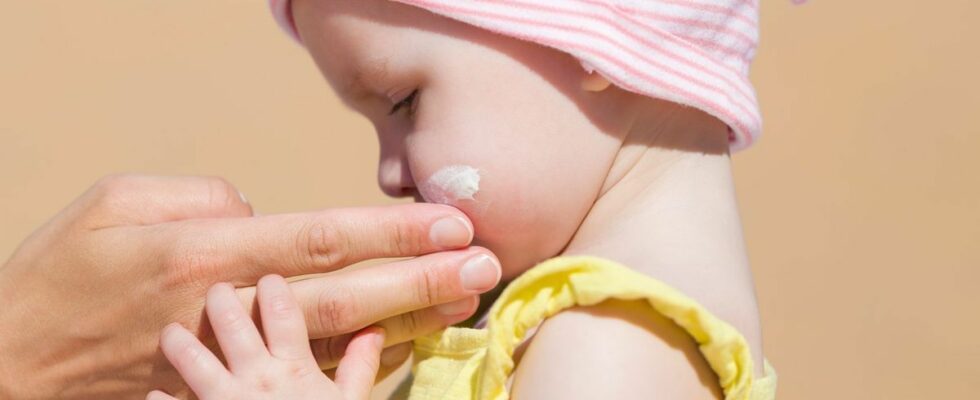Published on
Updated
Reading 2 min.
Are you going on holiday with a little one? Their exposure to the sun must be prepared. Discover the checklist of essentials to check when buying sun protection dedicated to your baby.
It seems that sunny days are on their way (almost) everywhere in the country. But with their thin and vulnerable skin, babies need to be particularly protected from the sun’s rays. Choosing the ideal sunscreen is therefore an essential step. Discover our advice.
Sunscreen is not enough and only serves as a “complement” to protection
Before talking about cream, however, it is important to remember one thing: for young children, it should only be applied in addition to suitable protection, and cannot be the only solution against the sun.
Thus, as detailed by Mpedia, the site for child specialists, “A baby aged 0 to 6 months should not be exposed to the sun at all”as their skin is still too fragile. From the age of 6 months, sunscreen will only be the last element of the child’s protection after:
- Respect for timetables (no exhibition between 10 a.m. and 4 p.m.);
- Looking for shady places;
- Wearing long/UV-protective clothing, a hat and sunglasses.
What protection should you choose for your baby?
If all reasonable precautions are taken, you can switch to sunscreen for outdoor time. Here’s what to look for when buying:
- Maximum protection index. Unsurprisingly, according to experts, it is a question of favoring the maximum protection index, that is to say SPF 50+ (Very High Protection), to limit the impact of the sun as much as possible. This index indicates that it filters UVA and UVB rays, which cause sunburn. On the other hand, we avoid index 30, which is quite insufficient.
- In a dermo pediatrics range. It is recommended to turn to a specific range of sunscreen “dermo pediatrics”, that is, specifically for small children. This range generally guarantees a sufficiently high SPF level, elements that respect the fragile skin of babies, as well as sufficient resistance to water, if swimming is involved.Please note that the words “kids”, “babies” or even “children” affixed to the products for sale should not influence you” add pediatricians on Mpedia;
- A mineral filter. Finally, it is better to favor mineral filters that act more quickly, whereas a chemical filter can take around twenty minutes before protecting the skin.
- Organic, preferably. Be careful, experts say, “The presence of an organic label is not a guarantee of ultimate quality, but it will allow you to turn to protection that is more respectful of your baby’s skin.”
In spray, in milk… which texture to choose?
In terms of textures, there is no real difference in protection, whether you have opted for a spray, a milk, a cream or a mist. However, a cream that is not very fluid and a little more oily is sometimes more practical to ensure that the skin is well covered. In addition, it prevents inhalation of the product during application. A full application every 3 hours minimum is recommended.
Finally, last tip: if these criteria show that baby cannot use your own sunscreen, nothing prevents you from using baby’s sunscreen, if you only want to take one tube in the bag!
